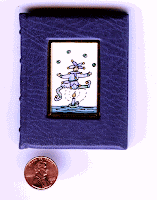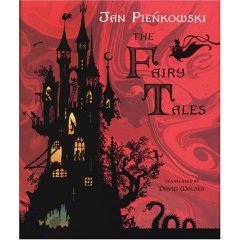
Online Exhibit of the Week: The Charlotte M. Smith Collection of Miniature Books
Here's the first entry of what (I hope) is a regular Thursday night feature on this blog. I adore perusing rare and unusual children's books. I spent a fair share of my time in library school nosing my way through the Elizabeth Nesbitt Room, and it was always like some delightful combination of treasure hunt and picnic. The handpainted colors! The gilded binding! The fact that I had my very own pair of little white gloves!
Naturally, I still crave such moments (children and work now occupy my once-abundant research time), and I'm sure there's a goodly number of folks out there who do too.
Therefore -- once a week, I will highlight fun, interesting, and delicious online exhibits about children's books and media.
This week, I bring you "Tiny Tomes," otherwise known as the Charlotte M. Smith Collection of Miniature Books.
The story of the collection's origins will resonate with any bibliophile -- Smith was such an avid collector of antique books that her shelves sagged with the weight of them all. She made a deal with her husband that she would limit her collection to books that would fit in a "bookroom" in their house. Clever woman: because of the space limitation, she decided to focus her collection on teeny tiny books. She ended up with over three thousand of them, all less than three inches high. Now the collection is in the hands of the University of Iowa, where it is cherished and enjoyed.
Back in 2001, I had the opportunity to sit next to the lovely Leo and Diane Dillon at a conference lunch. I asked them what direction children's illustration would be headed next. They (naturally) had two answers: first, they said that they thought graphic novels would be huge (check), but that they personally were very interested in minature books and printmaking.
The Smith exhibit highlights why two world-class illustrators would find this so. The collection (which includes a fine portion of children's books and abecedarians, as well as other kinds of books) includes a wealth of different kinds of printmaking and bookbinding. The challenge of making a tiny book seems to beckon bookmakers and book artists into using the most exotic papers, handmade calligraphy, and detailed embossing possible. (Be sure to check out the image below of the spectacular 3"x2 1/4" pop-up book about the Great Fire of London.) Not all of the books are necessarily "antiques" -- there are miniatures that date up through the 1980s, showing how this art form has appealed to bookmakers through the ages. In fact, you can't help looking at a few of them without developing the itch to make a few tiny books yourself.
As for the online exhibit itself, it's extensive and informative but a tad disorganized; the only way to view the books is to flip through the exhibit pages like you would a catalog. Unlike a catalog, there is no linked table of contents or index, which makes it difficult to find particular books. The exhibit is best enjoyed, therefore, if you have some time to kill and don't mind loading a lot of images that you might not care to see.
Interested in creating your own collection of tiny tomes at home? Besides making your own, I'd highly recommend starting out by purchasing Maurice Sendak's Nutshell Library, or Trina Schart Hyman's A Little Alphabet. Oh -- and the miniature version of Margaret Wise Brown's Little Fur Family is especially amusing, as the book itself is bound with plush fabric (my copy has spent many hours being cuddled by small children).
It's difficult to find tiny books at libraries, or even big-chain bookstores, so I'd recommend hunting for them at independent bookstores or independent online retailers (make note of the book's dimensions before purchasing). Bring along a tiny magnifying glass, and happy hunting!
Thursday, March 15, 2007
Subscribe to:
Post Comments (Atom)



2 comments:
I love your post. I am curious if you're familiar with the rare book room at the University of North Texas...they have quite an extensive "tiny book" collection going...and many other gems like historical (collectible) pop-up books. You should take a look:
http://www.library.unt.edu/rarebooks/exhibits/popup2/default.htm
Goody! Thanks for the link!
Post a Comment